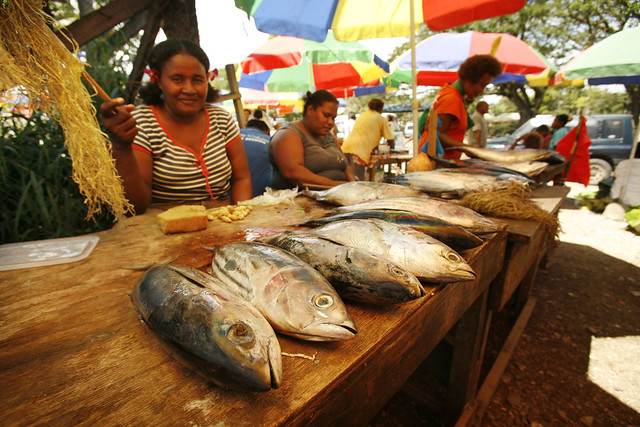New GAFSP proposal addresses fragility in the Solomon Islands

Like many Pacific Island countries, the Solomon Islands struggles with high rates of malnutrition, poverty, youth unemployment, a degraded environment and a changing climate.
A new funding proposal, prepared by FAO and IFAD for submission to the Global Agriculture and Food Security Program (GAFSP), seeks to address these challenges.
The GAFSP is a multilateral funding mechanism to fight hunger, malnutrition and poverty around the world.
In this latest call for proposals, 24 countries made fragile by climate challenges and/or conflict will vie for USD 100 million in competitive grant funding.
The project proposed for the Solomon Islands aims to make the country more resilient by increasing agricultural productivity, creating jobs, especially for women and young people, and improving food and nutrition security.
FAO agricultural officer Anton Glaeser, who helped design the proposal and organize broad-based stakeholder consultations, said the Solomon Islands faces the ‘triple burden of malnutrition’.
“By ‘triple burden’ we mean a combination of high rates of obesity, micronutrient deficiencies (including anaemia in women of reproductive age), as well as stunting and wasting in children,” he said.
More than one-third of the country’s children under-five years are stunted. More than two-thirds of adults are overweight and nearly one-third obese, with non-communicable diseases like diabetes and hypertension on the rise.
“This is especially severe in rural areas, and it’s exacerbated by the fact that the Solomon Islands imports a lot of inexpensive staples like rice and wheat as well as sugary drinks. These imported foodstuffs are much cheaper but less nutritious than what is traditionally grown, like taro, sweet potatoes and yams,” he added.
Getting more from the land
Around 80 percent of Solomon Islanders live in rural areas with limited access to infrastructure and services. They rely on agriculture and fisheries for their food and money.
The proposed project hopes to sustainably increase the agricultural output of deteriorating agroforestry systems, including the traditional subsistence homestead gardens.
The project aims to convert these areas into semi-commercial homestead gardens where families will grow vegetables, fruits, spices, and even raise pigs, poultry or tilapia in an integrated manner for the local market. A similar agroforestry approach will be used to revitalize abandoned cash crop areas, mainly planted with cocoa and coconut.
Reinvigorating these systems will increase the resilience of households to adverse weather conditions and prevent the loss of soil fertility.
They will also provide for a more varied, nutritious diet, while boosting incomes, especially from the cultivation of more lucrative cash crops like cocoa, vanilla, cardamom and ginger.
The project will raise awareness of the benefits of more commercial agriculture, including opportunities in processing, packaging and trade.
It will strengthen producer groups and saving and credit clubs, including among couples, helping them to develop viable agricultural business plans and access financing and financial services.
One big challenge, however, revolves around customary land issues, Glaeser said.
“If young people want to grow cash crops like cocoa on more than 2 hectares, for example, it’s difficult to find land. But there are options, like negotiating with traditional leaders to use under-utilised or unused land. What we’re trying to do is help the communities as a whole to see the long-term benefits and opportunities that come with people getting more involved in commercial agriculture,” he said.
Community outreach
Raising awareness of healthy diets based on local foods is another key focus. The project will use digital technology to get these messages across.
It will train local youth and government extension officers to produce short video clips on various topics, including improved nutrition, and then screen the clips and lead discussions in the communities.
“This IT-based approach is also an interesting way to get more rural youth involved in agriculture, helping to stem the migration to urban areas,” Glaeser said.
If GAFSP funding is granted, FAO will work with IFAD and the Government to prepare a detailed project proposal in line with the country’s new Agriculture Sector Growth and Investment Plan, currently under development.
Over the last several years, the FAO Investment Centre has helped design and/or provide technical assistance to numerous GAFSP projects implemented through FAO country offices, mainly in Africa and Asia. They have helped leverage around USD 328 million in funding for countries.
This latest round of GAFSP recipients will be announced in December.
